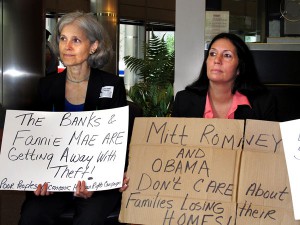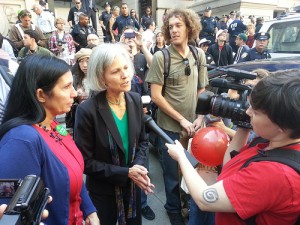On the Stein/Honkala Campaign Trail
Share


Philadelphia Police Captain Stephen Glenn, speaks with Cheri Honkala and Jill Stein in the Market Street bank lobby
“This has been such an easy campaign. It’s like giving out candy,” said Jill Stein, 2012 Green Party presidential candidate, who was recently nominated at the Green National Convention in July. “There is a rebellion going on out here and we [Stein/Honkala campaign] are the political platform for that rebellion. It is absolutely breathtaking.”
Stein said the troubled condition of the country and the lack of democratic politics is giving her Green agenda a rousing welcome from the public.
With neither the campaign of Republican Mitt Romney nor Democrat Barak Obama appearing willing to discuss the growing poverty rate, diminishing civil liberties, or looming environmental catastrophe, more and more are planning to vote Green this election. Jill Stein, who ran against Romney as a Green for Massachusetts governor, and running mate, Cheri Honkala directly address the needs of people— homeowners whose houses have been taken from them, young people indentured to student loans, and people of color sitting in jail purely because of their race.
“There is a storm surge we are riding. I never expected this” said Stein, a medical doctor and long time activist, who added that there has been a strong response to the campaign, not only from people under 30 and the unemployed, but also from loyal Democrats and Republicans who are persuaded by Stein’s pragmatic plan for fixing the future.
I would see myself more as “organizer-in-chief” where you the public are the driver of the country and I put it in place. ~ Jill Stein, candidate for President of the United States
She tells the story of giving an interview for National Public Radio in Oregon, which she said is not a “bastion of the Green uprising.” After talking for some time, the first caller said that as a “lifelong Democrat it was so wonderful to hear a platform that used to be like the Democratic platform 30 years ago.” Stein goes on to say the interviewer asked with surprise why the caller didn’t mention the spoiler effect, as was planned in the screening. “The caller then said that after hearing what I had to say he was voting Green. That is what it has been like the whole campaign.” She added that the next two callers, a retired navy pilot and a longtime Republican both were voting for her.
“Bringing the grassroots struggle into electoral politics and challenging the hijack of our electoral system and Wall Street gives me the liberty to talk about what we need and how we are going to fix these things. We need a green economy if we are going to survive. The public is aware that we need to bring the troops home now. It’s so exciting to me that there is a kind of real focusing now of the public voice, and the public mindset, and to my mind it’s very exciting to be able to provide a political vehicle for that consensus that has begun to really come into focus,” Stein said in an interview for Truthout.com with Yana Kunichoff on Aug. 9.
Ben Manski, Stein’s campaign manager since its beginning last fall, who has previously run for office as a Green himself, said that the campaign team is a winning coalition that appeals to a diverse population in the country. “The spirit of the campaign shows that Jill Stein is 110 percent committed to the struggle. She is walking picket lines and is deeply a part of the Occupy movement,” he said.
The Green Platform
The main component of this campaign that is appealing to so many is the Green New Deal (for an abridged summary of the Green New Deal, see page 4). It proposes a jobs program organized at the community level, and free health care and education. Many of the jobs would focus on transitioning to an environmentally sustainable economy. It would be funded in a number of ways, the first of which is to eliminate the massive tax breaks for multinational corporations and the extreme wealthy.
The New Deal program of the Great Depression in the 1930s inspired the Green New Deal. Stein said it worked then, and it could work now. She added that the 2009 federal stimulus package totaling a little more than $700 billion could have easily jumpstarted this program if it had been directed towards communities for growing their own food, creating renewable energy, and funding needed social jobs, such as those in education and healthcare.
Civil Disobedience

Jill Stein and Cheri Honkala at a sit-in in August 2012 at the Fannie Mae offices in Philadelphia to call for a halt to foreclosures. Of the 50 people protesting, four were arrested, including Stein and Honkala.
Both Honkala and Stein have been actively engaged with the Occupy movement, calling for economic justice. Honkala is an activist for the homeless and disenfranchised. She has been a strong voice for those who are rarely represented. Their campaign includes provisions for creating equality in political representation and giving communities a stronger voice. Honkala and Stein were recently arrested in Philadelphia for protesting unfair foreclosures by the lending organization Fannie Mae.
“The laws and budgets and procedures are designed to protect the lenders and to extract as much money as possible from their victims,” Honkala explained. “This isn’t the way it would be if we really had a government of the people, by the people, and for the people. The first priorities of government should be keeping families in their homes, and providing restitution for the deception and fraud that has robbed millions of Americans of financial security.”
Stein and Honkala were part of a sit-in at the Fannie Mae offices to call for a halt to foreclosures by the government-sponsored mortgage company of the homes of two residents who have lived in their homes for decades, and now face homelessness. Of the 50 people protesting, four were arrested, including Stein and Honkala. The candidates said the protest brought attention to the staggering fact that 8 million Americans face eviction and more than half of people in the country live in poverty. Of the monies set aside by Congress to aid homeowners in keeping their homes, only ten10 percent of those funds have been distributed.
“There is much more interest in Washington in protecting the profits of banks than in getting this aid out to the families whose lives are falling apart. President Obama held a big press conference to announce a program that would supposedly help 1.5 million homeowners, and, so far, it has actually helped only 1 percent of that number. Real help goes to the CEOs who play golf with the President, and the people get lip service. This will change only if the people stand up and say, ‘We’re not going to put up with it anymore,'” Stein said.
To address the mortgage crisis, under the Green New Deal, Stein would issue an executive order establishing a moratorium on foreclosures of occupied dwellings. Municipalities governed by Greens would get homeowners out of underwater mortgages by seizing mortgages through eminent domain and letting non-profit community development organizations—not Wall Street banks—reissue the mortgages.
Creating an American Democracy
In addition to dramatically reducing military spending, providing for a cleaner, safer environment, and addressing the pervasive culture of violence in this country, especially toward people of color, the Stein/ Honkala campaign is about bringing democracy to government.
The United States has become like the emperor without any clothes. Stein’s campaign is signaling loud and clear that the country is naked—of anything resembling a democratic society. But Stein says it is not impossible to get it back. As an example, she points out that when the public got wind of the imminent passing of the anti-Internet piracy act (SOPA), it was stopped in its tracks. “This is how politics can work,” Stein said. As president, she said, she would be in the perfect position to act as a whistleblower on any miscreance by Congress. “I would see myself more as ‘organizer-in-chief’ where you the public are the driver of the country and I put it in place.”
Successes on the campaign trail
People across the country are putting their money behind their convictions, as the campaign was able to raise enough funds to qualify for federal matching funds. To secure matching funds, the campaign needed to raise at least $5,000 from individual donations of no higher than $250 in at least 20 states. As of July, the Stein/Honkala campaign was able to qualify in 22 states. This is the first time a nominated Green Party candidate (Nader was endorsed) has qualified for the federal funds. This feat was possible despite the present economic crisis, due to the concerted effort early in the campaign by local Greens within each state, and the campaign team.
Stein and Honkala are planning to raise $1 million for this campaign. Green Party candidates do not accept corporate donations, and Stein is no different. All funds are raised from individual Americans and this way Stein is not beholden to anyone but the public. “As we take money out of politics, we take back our democracy,” she said.
Manski, the campaign’s manager, said early in the campaign, which started in the fall of 2011, that they tried to be methodical and focus on accomplishable goals. Fundraising and getting ballot status were top priorities and the team made sure that each step was made at the appropriate time.
As a result, not only was Stein able to get matching federal funds, but also to work with state Greens to secure ballot status in more than 30 states so far. The plan is to have a Green Party ballot line in a total of 40 states. The campaign is currently seeking ballot status in Alabama, Connecticut, Kansas, Kentucky, Nebraska, Nevada, New Hampshire, North Dakota, Rhode Island, South Dakota, Vermont, and Wyoming.
A campaign of the 99 percent?

Green Party presidential candidate Jill Stein speaks to reporters in front of the National Museum of the American Indian at Occupy Wall Street. Photo by Alex Jung.
Stein has been active in the Occupy Movement and is finding a broad base of support as people see the Green Party as representing the 99 percent. “At Occupy events, they used to have nothing to do with Greens. Now they have realized they have to fight the fight for the voting booth. … We have majority support in the issues— the numbers clearly show this,” Stein said.
Also Stein is finding strong support especially from young Americans. She said the younger generation is “unstoppable” and will be giving the Stein/Honkala campaign their votes. A favorite story of Stein’s is from her first event in the campaign. It was at a mock election at Western Illinois University. Apparently this event is notorious for accurately predicting the outcome of actual presidential elections. Before her speech, Stein had three percent of the votes but after speaking for six minutes, 26 percent of these Midwestern students were voting Green. After that event Stein said she knew the country is at a pivotal moment. “This is like the perfect storm for taking back Democracy.”






In order to weaken the inevitable but phony argument that “a vote for Stein can enable a Republican victory,” which is what the Dems keep saying about the 2000 “Nader effect,” it would be wise to establish a “Republicans for Stein” and “Independents for Stein” organizations to prove that she has support across the board and is not “stealing” (sic) Democratic votes. Jon– Green since 1989
Go for it, Jon. Contact the campaign and volunteer to start those groups!